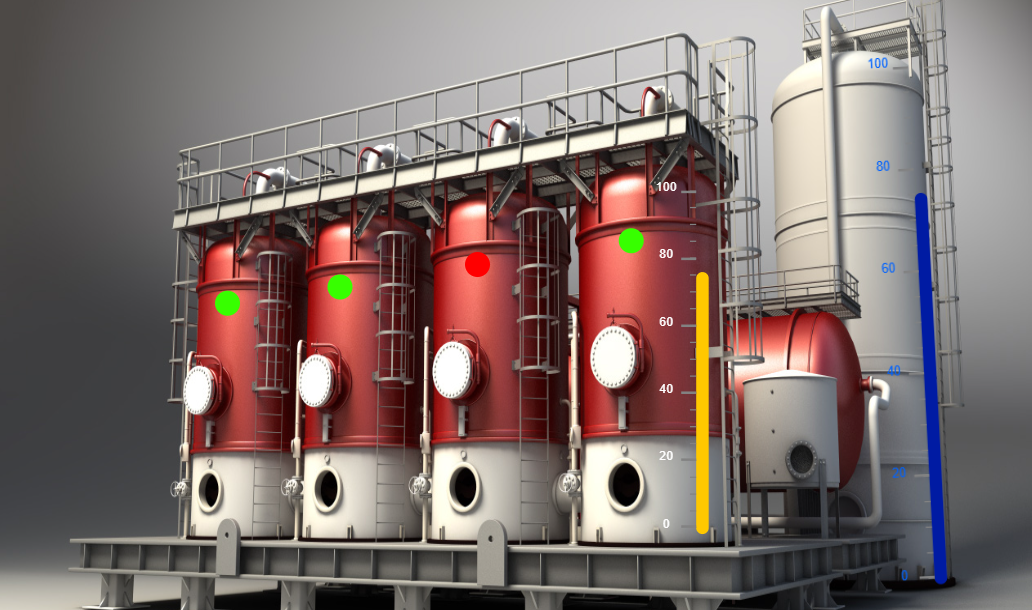What is an alarm in SCADA?
In industrial environments, especially those with complex systems like SCADA (Supervisory Control and Data Acquisition), effective monitoring and control are crucial for safety and operational efficiency. A SCADA system collects data from remote locations, monitors processes, and controls equipment in real-time. An essential component of SCADA systems is alarms, which alert operators to abnormal conditions or potential issues that may require immediate attention.
Alarm management is a critical process in SCADA systems, ensuring that alarms are appropriately triggered, prioritized, acknowledged, and resolved. Proper alarm management helps avoid alarm fatigue, ensuring that operators respond to alarms that are truly critical, ultimately enhancing system reliability and safety.

What is an Alarm in SCADA?
An alarm in SCADA is a signal or alert generated by the system in response to a defined condition or threshold being exceeded. SCADA systems monitor various variables—such as temperature, pressure, or flow rate—across a network of sensors and devices. When these values reach critical levels, the system triggers alarms to inform operators of potential problems. These alarms help operators make informed decisions about whether to take corrective action to prevent equipment damage, process failure, or safety incidents.
Alarm management is a key aspect of process control in SCADA systems, ensuring that alarms are relevant, timely, and actionable. Without proper alarm management, a SCADA system could flood operators with unnecessary alerts, leading to alarm fatigue and potentially missed critical warnings.
What is an Alarm and Event?
An alarm and an event, while related, serve different functions in a SCADA system. An alarm is an immediate and critical notification that requires operator intervention. It indicates an abnormal condition or a risk to the system. An event, on the other hand, is a less urgent notification, often indicating a change in state or status that doesn't necessarily require immediate action but should be logged and monitored.
For example, if a pump speed falls below a certain threshold, it might generate an event for recording purposes. However, if the pump fails completely, this would trigger an alarm, signaling that operator intervention is required.
What is an Alarm Used For?
The purpose of alarms in SCADA is to provide real-time alerts that help operators and control personnel to detect and address issues before they escalate into more severe problems. Alarms are used to:
- Protect equipment: By alerting operators when equipment is operating outside of its normal parameters, alarms prevent costly damage and downtime.
- Ensure safety: In critical industries like oil and gas, power generation, and water treatment, SCADA alarms are vital for maintaining operational safety and preventing hazardous situations.
- Regulate operations: Alarms help operators keep the process running within predefined limits, ensuring efficient and stable operations.

What is Alarm Notification?
Alarm notifications are the mechanisms by which alarms are communicated to operators. SCADA systems typically feature an alarm notification system that delivers alerts via various communication channels, such as emails, text messages, or visual signals on control panels. The notification system helps ensure that the right personnel receive timely and clear warnings about the status of the system, especially during off-hours or when operators are in different locations.
Effective alarm notification systems allow for alarm prioritization, helping operators focus on the most critical issues first. They also enable operators to acknowledge and acknowledge alarms to confirm actions or resolutions.
What are the SCADA Alarm States?
SCADA systems employ various alarm states to categorize the severity and action required for each alarm. The typical SCADA alarm notification software will support several states, such as:
- Active: The alarm condition is currently happening and requires attention.
- Acknowledged: The alarm has been noticed by the operator, but the issue may still need resolution.
- Resolved: The problem has been addressed, and the alarm is no longer active.
Inhibited: The alarm is temporarily disabled, usually due to planned maintenance or system changes.
What are the Levels of SCADA Alarm?
SCADA alarms are often categorized into different levels of severity, helping operators prioritize their responses. These levels include:
- Critical (Level 1): These alarms indicate serious, immediate threats to safety or equipment. Immediate intervention is required.
- Major (Level 2): Important but less urgent issues, such as operational disturbances, require attention within a set time frame.
- Minor (Level 3): Non-urgent alarms related to routine maintenance or less severe operational issues.
Each level of alarm is configured to trigger notifications according to its importance, ensuring that operators respond appropriately.

What are the Different Types of SCADA Alarms?
SCADA systems support a variety of alarm types to address different conditions and operational needs. These include:
- Process alarms: Triggered when a specific process variable, such as temperature or pressure, exceeds or falls below its setpoint.
- Equipment alarms: Generated when equipment operates outside its defined range, like a pump running dry or a motor overheating.
- System alarms: Related to the overall health of the SCADA system, such as communication failures or software malfunctions.
Understanding the types of alarms in SCADA is critical for operators to interpret alarms correctly and act accordingly.
What is the Difference Between an Alarm and a Warning?
While both alarms and warnings serve to alert operators, the main difference lies in their urgency. An alarm typically signals a critical issue that requires immediate attention to prevent damage or failure. A warning, on the other hand, is a less critical message indicating that something is approaching a threshold but does not require immediate intervention.
For example, a warning might indicate that a temperature is nearing a high limit, while an alarm would be triggered if the temperature exceeds that limit.
What is the Difference Between Alarm and Event in SCADA?
The distinction between an alarm and an event in SCADA is subtle but significant. An alarm signifies an urgent condition that demands immediate operator action, while an event is a recorded status change or occurrence that does not necessarily require a response but is logged for future analysis.
For example, a pressure drop in a pipeline might be logged as an event, but if the pressure reaches a dangerous level, it triggers an alarm. Both are useful, but alarms require action, while events are more informational.
Conclusion
Alarms play an essential role in SCADA systems, ensuring that operators are aware of critical conditions in real time. By using alarm management systems, organizations can effectively monitor operations, protect equipment, maintain safety standards, and optimize performance. Understanding the different types of alarms, their states, and their notification systems is crucial for anyone working with SCADA systems. Properly configuring and responding to alarms can help prevent costly downtime, improve process efficiency, and maintain overall system integrity.
If you're looking to enhance your SCADA system's alarm management, consider exploring advanced SCADA alarm notification software to ensure reliable, timely, and effective alerts. Stay ahead of potential issues with the right alarm management solutions for your operations, contact us today!
You might also like



